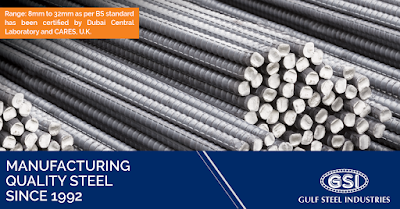Using Thermo Mechanical Treatment, high-strength reinforcement steel bars are produced, which is commonly known as TMT Steel Rebars. These bars are widely used in the construction industry as they possess several qualities other than strength. TMT bars are in great demand in the construction world due to their unique metallurgical process that combines work hardening along with heat treatment to create robust and high strength bars from low-carbon steel. They are economically viable when compared to conventional steel bars.
Thermo Mechanically Treated Steel bars are mostly used in concrete reinforcement structures, residential buildings, high-rise commercial buildings, flyovers, dams, bridges, thermal plants, industrial structures, and hydel power plants. They are capable of withstanding heavy loads compared to normal steel and are especially known for their high tensile strength and ductility.
The manufacturing process of TMT steel rebars includes 5 steps:
Extraction of iron from its ore: Iron ore plays an important role in manufacturing the TMT bar. Under this process, raw materials such as iron ore, coke, limestone, etc. are kept in a molten state. When it is the molten stage, all these materials are treated on hot gases. The molten iron is then poured into a casting machine to be shaped into the desired shape.
Heating, Rolling, and formation of reinforced bar: The steel billets are heated from 1200°C [2192 F] to 1250°C [2282 F] and are passed through a rolling mill to give shape. In the rolling mill stand, it is heated and rolled rapidly.
Quenching: It forms the most crucial stage in the TMT bars manufacturing process. After the milling stand, the bars are quenched by a special water spray system. This is performed to harden the outer surface of the steel. This process benefits to increase the tensile strength, size of shrinks, and durability.
Self-Tempering: Once the rebar is out of the quenching box, the core remains hot compared to the surface. The heat flows from the core and gets transferred to the outer surface of the bar. This causes the desired tempering of the outer martensitic layer into a structure called ‘tempered martensitic’. It makes the bars highly ductile.
Atmospheric Cooling: This is the final step in the TMT manufacturing process. It involves laying down the bar on a cooling bed at normal temperature. When the bars are cooled down, the final structure will have a strong outer layer with a ductile core.
Gulf Steel is ranked as one of the most reputed Steel Manufacturer in UAE. They are one of the best producers of construction steel and are a CARE-approved steel company in UAE. If you have any requirements for good quality Thermo Mechanically Treated Steel bars, contact Gulf Steel.


